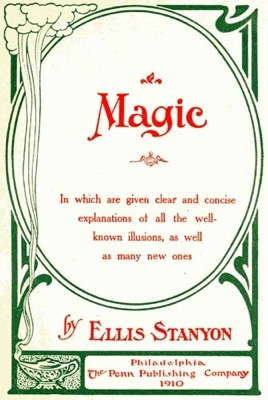

Magic
In which are given clear and concise
explanations of all the well-known
illusions, as well as many
new ones
byEllis Stanyon
Philadelphia
The Penn Publishing Company
1910
Copyright 1901 by The Penn Publishing Company
Contents
| CHAP. | PAGE | |
| I. | INTRODUCTION | 11 |
| II. | PRINCIPLES OF SLEIGHT OF HAND APPLICABLE TO SMALL OBJECTS | 26 |
| III. | TRICKS WITH COINS | 33 |
| IV. | TRICKS WITH HANDKERCHIEFS | 57 |
| V. | TRICKS WITH BALLS | 93 |
| VI. | HAT TRICKS | 114 |
| VII. | ANTI-SPIRITUALISTIC TRICKS | 127 |
| VIII. | AFTER DINNER TRICKS | 142 |
| IX. | MISCELLANEOUS TRICKS | 159 |
| X. | STAGE TRICKS | 209 |
| XI. | SHADOWGRAPHY | 228 |
Preface
The art of pretended magic dates back to the remotest antiquity. It has been known under various names, such as White Magic, Conjuring, Natural Magic, and Prestidigitation. Jannes and Jambres, the magicians of Pharaoh, contended against Moses and Aaron. In the British Museum there is an Egyptian papyrus, which contains an account of a magical seance given by a thaumaturgist named Tchatcha-em-ankh before King Khufu,b.c., 3766. In this manuscript it is stated of the magician: "He knoweth how to bind on a head which hath been cut off, and he knoweth how to make a lion follow him as if led by a rope." The decapitation trick is thus no new thing, while the experiment with the lion, unquestionably a hypnotic feat, shows hypnotism to be old.
The temples of Egypt, Greece and Rome were veritable storehouses of magic and mystery. The pagan priesthood attained a wonderful proficiency in optical illusions. In the Middle Ages magic was greatly in vogue. Later on Nostradamus conjured up the vision of the future king of France for the benefit of the lovely Marie de Medicis. This illusion was accompli